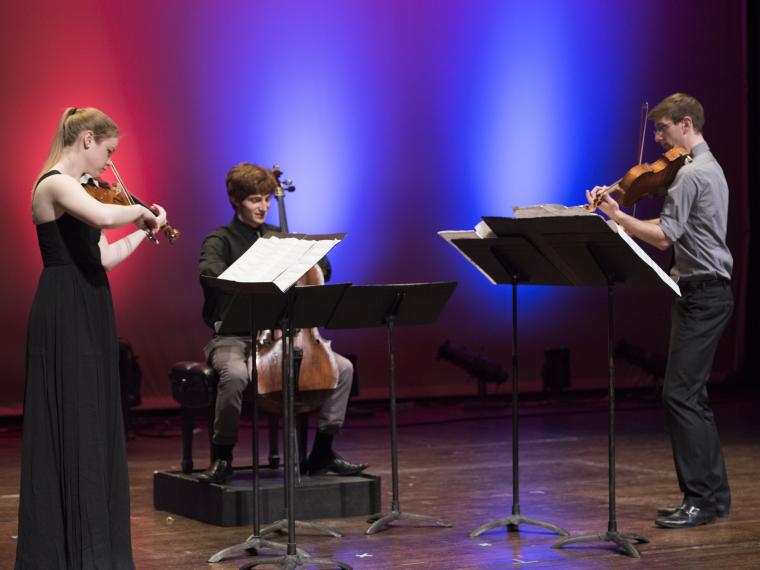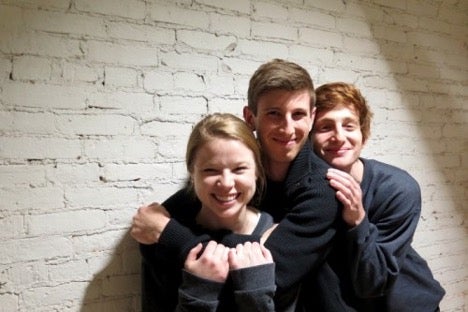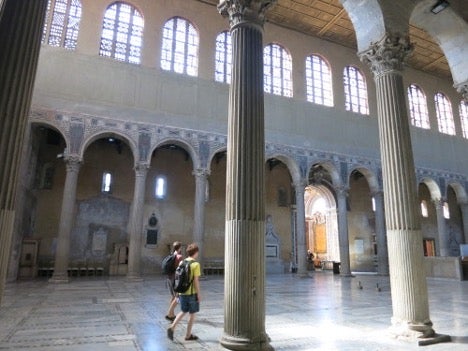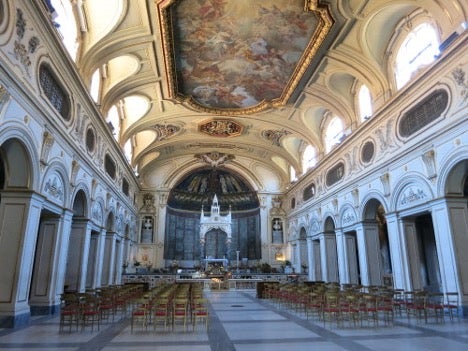When in Rome...Make Music
June 1, 2017
Cathy Partlow Strauss '84

Photo credit: Margot Schulman
A student-formed ensemble enjoys high-profile gigs and a quest for deeper understanding.
Violinist Dana Johnson ’17, double-degree violist Corey Worley ’18, and cellist Aaron Wolff ’17 became Trio Ligatura out of a shared excitement about new music and a reconception of what it means to be a young classical musician in the 21st century. Formed in 2015 at Oberlin Conservatory, the trio expressed its passion through performances of 20th- and 21st-century compositions while frequently collaborating with living composers and artists.
During their time here, they appeared on the Danenberg Honors Recital; represented Oberlin on the Kennedy Center’s Conservatory Project series in Washington, D.C.; and performed on WOBC-FM 91.5's "Live from Studio B” and on Cleveland’s classical station WCLV-FM 104.9. They also worked in master classes with resident and guest artists at Oberlin—the Calder Quartet, Dimitri Murrath, and the Mivos String Quartet.
The trio's members each learned and exercised their entrepreneurial chops, mining Oberlin’s numerous student funding sources and using online crowd-funding platforms. They designed their own concert tours, giving performances in Ann Arbor, Detroit, Chicago, and at the SoundSCAPE Festival in Maccagno, Italy.
Much of their 2015-16 academic year was focused on Andrew Norman’s The Companion Guide to Rome, a 30-minute series of musical portraits of nine Roman churches. Following two high-profile performances of the piece on the honors recital and at the Kennedy Center, the trio decided to deepen its relationship with the work through a trip to Rome. They wanted to capture the experience of being in each of the churches in an attempt to bring to life the artistic and interpretive processes of creating something inspired by previous works of art. Their Rome venture was supported by an XARTS grant, a competitive, adjudicated granting program administered through Oberlin’s Creativity and Leadership Project.
With funding in place, they headed to Rome. There, they spent significant time in the churches featured in Norman’s work: gathering video footage, creating short audio recordings in the spaces, and writing about their experiences, all for use in the creation of a multimedia installation. (Read the Q&A below to learn more about their tour experience.)
“One thing we learned through the entire process of this trip was to always ask—ask for help, ask for contacts, ask to see something extra, ask about the history," the trio wrote. "We learned and experienced so much, we connected with people at these churches, and we certainly developed as a team. And from that, we definitely feel more connected to the piece now that we have visited and experienced its inspiration for ourselves. The gestures feel more real, there’s less guesswork, we have a unified and solid vision of what these movements are referencing. But we also each have our own take and our own experiences to bring to the table, which will hopefully make for a more genuine and personalized performance.”
The resulting installation, Beyond the Black Dots: Expanding the Interpretive Process, debuted on Commencement/Reunion Weekend in May 2017. Oberlin’s Birenbaum Innovation and Performance Space offered the ideal environment to showcase the daylong work. The trio had created a looped 30-minute audio/video presentation interspersed with two full live performances of Norman's trio. They enjoyed consistently full audiences of alumni, parents, and about-to-be grads. The experience proved a fitting culmination of the trio’s undergraduate work—both Johnson and Wolff marched across the commencement stage later that weekend.
Trio Ligatura Tour Q&A

When you all decided to keep exploring Andrew Norman’s piece, what became your final objective for the project?
We decided to dive deeper into Norman’s piece and came up with the idea to do a multimedia installation here in Oberlin with the intent to capture the experience of being in the churches and bring to life the artistic and interpretive processes of creating something inspired by previous works of art. So while in Rome, we visited each of the churches featured in Norman’s work to gather video footage and audio recordings, as well as some written responses, to be used in our installation. This semester we will be putting together what we collected in Italy, and the installation will be coming soon!

What was your favorite place featured in Andrew Norman’s cycle that you consequently visited on your trip?
We really enjoyed visiting the church of St. Sabina. The movement featuring this church is the ninth and final of the piece. It is also the longest and, in a way, functions as the culmination of the entire work. It is incredibly moving and depicts a sunrise streaming in through the large translucent stone windows of this church. This movement in particular is really special to all of us, so visiting the church and seeing the light coming in through the windows—an experience we had imagined and portrayed through the music countless times—was really memorable for us.
Did you have a particular process for exploring each destination?
We generally would get our gear set up outside the church so that we could get video footage and audio samples of every aspect of our experiences in the space. And we did have some technical difficulties at times, but we eventually got the hang of an efficient way to work with the equipment. We found that going through this detailed documentation process in each church allowed us to see the spaces in a more comprehensive way—it was very mindful work and somewhat refreshing to be able to spend the time to get really in-depth looks at each building. Most of the churches were not super touristy, so it wasn’t too difficult to get around inside. The busiest one we encountered was visiting the church with Bernini’s "Ecstasy of St. Teresa" (inspiration for the first movement). That was a very small church and probably the most well-known of the ones we visited. There were a few we weren’t able to get inside of due to restorations, but each church had a very different environment. Our priority, though, with our process, wherever we went, was to be respectful and unobtrusive while still getting the samples we needed for our project.

After seeing all these places in real life, is there one that is described in Norman’s piece particularly well in your opinion?
We thought that the first movement, Teresa, was described quite accurately. The loudness of the decoration in such a small architectural space was reflected in our simultaneous three-person crazed cadenza that lasts less than a minute. Additionally, Clemente was a very interesting space in which the new (current), spacious church was built upon the old, which is still accessible but an eerie shadow of the past, essentially unusable and crumbling away. In the movement Clemente, the violin and viola share an ethereal duet that really captures the essence of this crumbling piece of history.
Has this trip changed your perspective on traveling/discovering new places? And how has this trip changed each of your perspectives on the piece and your approach to the piece as an ensemble?
In terms of traveling and discovering new places, one thing we learned through the entire process of this trip was to always ask—ask for help, ask for contacts, ask to see something extra, ask about the history. We learned and experienced so much, we connected with people at these churches, and we certainly developed as a team. And from that, we definitely feel more connected to the piece now that we have visited and experienced its inspiration for ourselves. The gestures feel more real, there’s less guesswork, we have a unified and solid vision of what these movements are referencing. But we also each have our own take and our own experiences to bring to the table which will hopefully make for a more genuine and personalized performance.
You may also like…
Josh Nolan Named Vice President, General Counsel, and Secretary at Oberlin
Distinguished attorney brings extensive experience in higher education law.
Learning by Teaching: Oberlin Students Share Global Music with Young Learners
College and Conservatory students in PACE 103 prepare local children for an immersive community concert at Oberlin.
Nuiko Wadden ’02 Joins Oberlin Conservatory Faculty as Assistant Professor of Harp
The versatile musician brings extensive opera, orchestral, and contemporary music experience to her role


